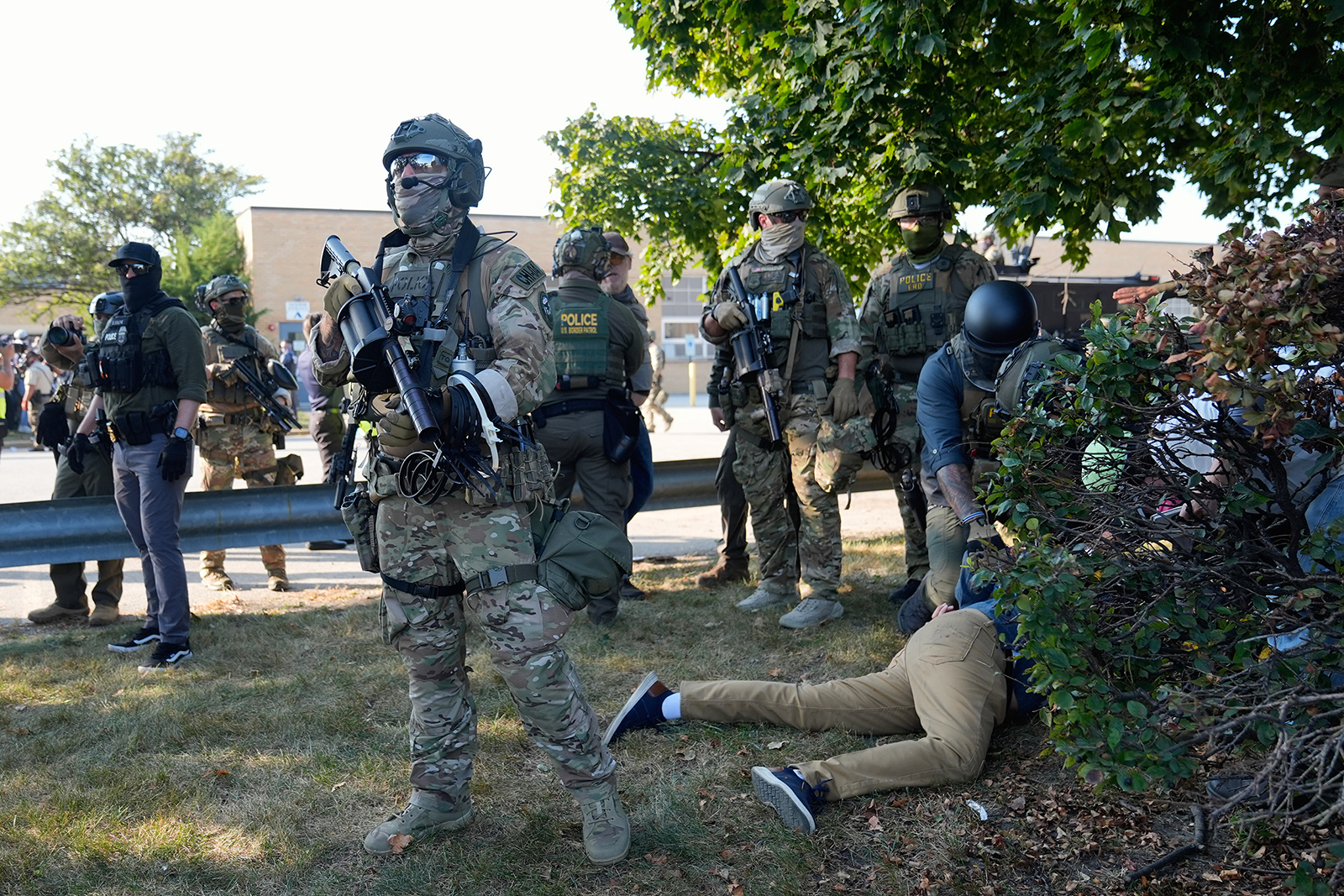
(RNS) — Last month, the Rev. David Black stood in front of a Chicago-area U.S. Immigration and Customs Enforcement facility and spread his arms wide. Adorned in all black and wearing a clerical collar, the pastor looked up at a group of masked, heavily armed ICE agents on the roof and began to pray.
“I invited them to repentance,” Black, a minister in the Presbyterian Church (USA), said in an interview. “I basically offered an altar call. I invited them to come and receive that salvation, and be part of the kingdom that is coming.”
But when Black began to lower his arms a few seconds later, the agents responded to his spiritual plea by firing pepper balls, or chemical agents that cause eye irritation and respiratory distress, video footage shows. One struck Black in the head, exploding into a puff of white pepper smoke and forcing him to his knees. Fellow demonstrators rushed to his aid, and as the pastor rubbed his face in pain, the agents continued to fire.
“We could hear them laughing,” Black said.
It was one of several dramatic and violent scenes that unfolded in recent weeks near an ICE detention facility in Broadview, Illinois. About 12 miles from downtown Chicago, the suburban site has seen scores of demonstrators repeatedly confront ICE agents — sometimes jeering at agents or using acts of civil disobedience to block the entrance to the facility as part of a groundswell of protests against President Donald Trump’s ongoing immigration crackdown in the city. The agents, mostly masked, have often responded with force, arresting demonstrators, tossing gas canisters, firing nonlethal rounds at activists and journalists and sometimes throwing protesters — including at least one local Democratic congressional candidate — to the ground.
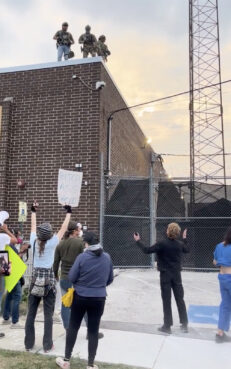
The Rev. David Black prays below masked agents on the rooftop of a U.S. Immigration and Customs Enforcement detention facility in Broadview, Ill. (Video screen grab)
But despite the danger, religious leaders and faith activists have been a visible presence at the protests, some waving signs with slogans such as “Love thy neighbor” and “Who would Jesus deport?” Many argue they are compelled by their religious beliefs to advocate for immigrants, but as officers continue to respond with violence, some claim their religious freedom is increasingly at risk — even, they say, as the pray for the souls of ICE agents.
“One of the chants that has become ubiquitous at these protests at Broadview is, ‘Love your neighbor, love your God, save your soul and quit your job,’” said Black, who pastors at the First Presbyterian Church of Chicago. “Everybody chants that.”
The Rev. Hannah Kardon, a United Methodist pastor who leads United Church of Rogers Park in Chicago, has also protested at the Broadview facility on several occasions. She, like Black, said she has been shot multiple times with pepper bullets, including while she was praying with her eyes closed and hands lifted, wearing a clerical collar and stole. She said she often prays for the ICE agents, but especially for the immigrants detained inside.
“I am praying for all of the people inside to be returned to their communities,” she said. “These are our friends, our family, our cousins, our uncles. These are our community members, and they are being stolen.”
At least once, Kardon said, agents fired a pepper ball at her without warning, leaving her with a bruise on her abdomen that has lasted for weeks.
“Every time we have been attacked with pepper bullets or tear gas or pepper spray that I have been present, it has felt like it came from anger that we were there, and not from any determined safety need or protocol,” she said. “They are unhinged.”
The pastors’ efforts are part of rising faith-based pushback to the Trump administration as the president seeks to implement plans for mass deportation of immigrants. Prominent religious leaders — including, as of last week, two popes — have criticized Trump’s policies. And clergy were a fixture at protests in Los Angeles and Washington, D.C., after the president flooded the cities with federal agents and tasked National Guard troops with deporting immigrants and combating what he claimed was rising crime, a point of heated dispute.
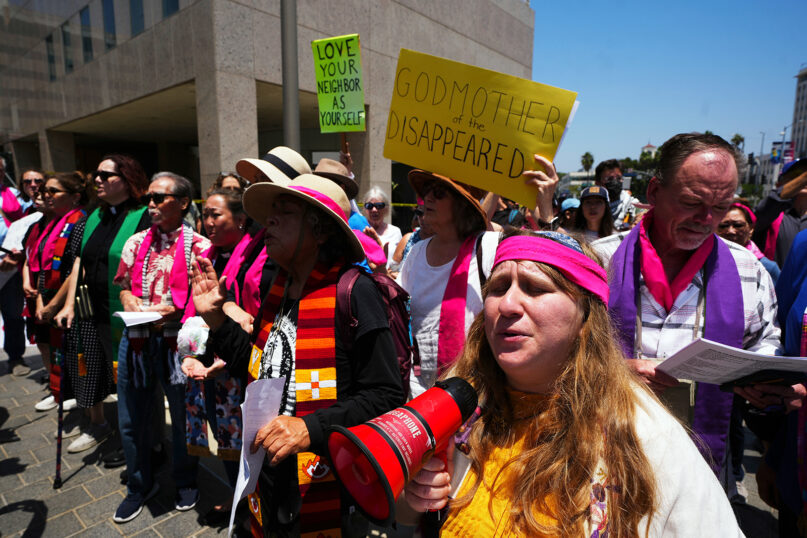
Protesters, including many clergy, gather to denounce U.S. Immigration and Customs Enforcement operations, June 10, 2025, in downtown Los Angeles. (AP Photo/Damian Dovarganes)
Churches with immigrant-heavy populations have seen attendance drop, and others have had direct encounters with ICE. Federal agents have conducted immigration enforcement near or on the grounds of U.S. churches at least 10 times this year, prompting one California pastor to confront apparent federal agents as they apprehended people in her church parking lot in June.
Dozens of faith groups and denominations have also filed lawsuits challenging Trump’s various immigration policies, and the treatment of religious demonstrators at the Chicago facility has become a legal flashpoint. Black is listed as a plaintiff in a lawsuit filed this week against Department of Homeland Security Secretary Kristi Noem alleging violations of the First and Fourth Amendments. Although most of the plaintiffs are journalists, Black is named as one of multiple clergy and faith-based demonstrators who, lawyers argue, have fallen victim to violence that violates the Religious Freedom Restoration Act.
The lawsuit accuses ICE agents at the facility of enacting a “policy, pattern, and practice” of “targeting Rev. Black and other similarly situated Religious Exercise subclass members with violence.” The result, the complaint alleges, “substantially burdens their exercise of religion.”
Speaking to RNS the same day the lawsuit was filed, Black said his “freedom to minister Christianity and to proclaim the good news in the United States of America is very much being infringed and threatened.” He also said he still suffers from respiratory issues weeks after agents shot him with pepper balls, an act he framed as “retaliation of my federal government (against) my acts of ministry.”
He added, “I absolutely feel that my First Amendment rights have been infringed, and anticipate that there is a plan to do so more.”
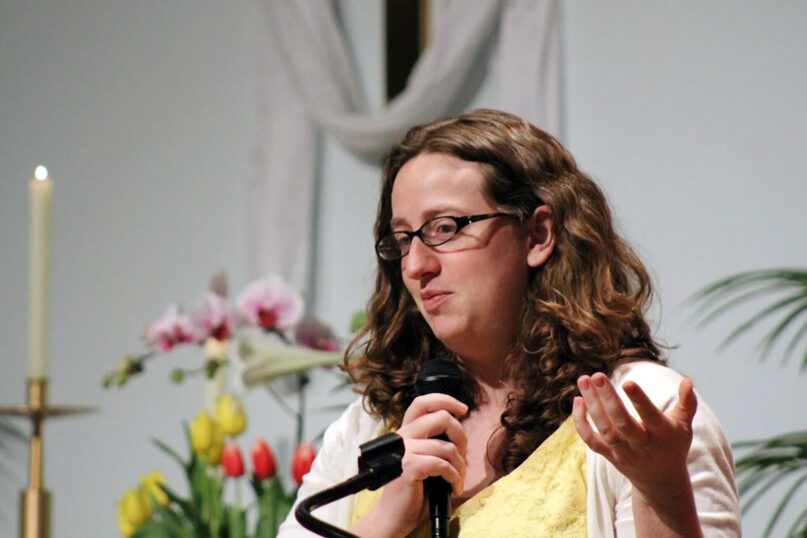
The Rev. Hannah Kardon. (Photo courtesy of the United Church of Rogers Park)
Kardon agreed, saying she believes her religious freedom is one of several rights that have been infringed upon by agents at Broadview. Even so, Kardon said she is determined to continue protesting and plans to participate in an ecumenical Communion service outside the facility later this week. Her desire to advocate for immigrants, she said, is rooted in “stuff that God put in every single one of us.”
“We’re a faith of immigrants — Jesus was an immigrant,” she said. “But to me, this is basic created-being stuff. When you see what is happening here, your whole body and heart resists it because it’s fundamentally wrong.”
DHS did not respond to questions about the new lawsuit, nor did officials directly respond to questions about the incident in which Black was shot with pepper balls. However, DHS Assistant Secretary Tricia McLaughlin sent a statement calling the protesters “rioters” and accusing them of assaulting law enforcement by throwing “tear gas cans, rocks, bottles, and fireworks” at officers.
She added, “these rioters endanger the safety of our brave law enforcement officers and the illegal aliens inside the facility.”
Black and Kardon reacted with frustration to the agency’s claims and characterizations, dismissing the idea that protesters like themselves could be considered dangerous.
“I’m a mom of two who bakes stuff and wears rainbow glasses,” Kardon said. “No one in their life has ever been scared of me.”
But DHS continued its negative characterization of protesters on Friday (Oct. 3), when Noem visited the Broadview facility. In a speech to agents recorded by right-wing activist Benny Johnson, the secretary argued the protesters outside the facility were “advocating for violence against the American people” and were “victimizing people every day by the way that they’re talking, speaking, who they’re affiliated with, (and) who they’re funded (by).”
In his post containing the video, which was retweeted by the official DHS X account, Johnson said that “left-wing extremists” had surrounded the ICE facility but that “federal agents crushed the threat immediately.”
Religious activists rejected the claims and dismissed the idea that they are funded by anyone.
“The idea that we have funders is ludicrous,” Black said in a text message.
According to activists and footage taken outside the facility by independent journalists at Unraveled Press and others, Noem gave her speech around the time clergy and a large group of Jewish demonstrators, most of whom had spent the morning singing religious songs, were assembled outside the facility. Photographs and video clips show Jewish protesters, some affiliated with the left-wing group IfNotNow, standing under a banner that read “God’s love knows no borders” and wearing tallits, or prayer shawls. Later, as ICE vehicles were driven near the protesters, Jewish demonstrators were among those shoved by local police as they stood along the side of the road and, in some cases, attempted to block the cars, video footage shows.
Singing with the Jewish group near the Broadview facility that day was Adam Gottlieb, a cantorial soloist at Tzedek Chicago, a local Jewish congregation. They have participated in several protests outside the Broadview facility, including one instance last month when Gottlieb was with other musicians as they were struck by non-lethal munitions. The projectiles, Gottlieb said, left a hole in a guitar.
Gottlieb said they were also shoved by police the day Noem visited the center, and believes their religious freedom has been violated.
“This commandment to love our neighbor is not so much about a feeling that we’re supposed to just feel in our hearts, although it is that too,” Gottlieb said. “It’s made real through action. What we’re called to do now, those of us who are people of conscience, whether we’re from a faith tradition or not, is to take action to protect the most vulnerable people in our society.”
Some faith activists and leaders have found themselves in handcuffs. The following evening, Rabbi Michael Ben Yosef, a local activist and regular presence at the protests, was among those detained by police at a protest. Footage showed four officers holding him down as he was arrested.
DHS, meanwhile, has also invoked faith — especially Christianity — to promote its actions. The agency has produced promotional videos that overlay Scripture on top of images of ICE agents conducting raids. And on Tuesday, the DHS X feed posted a new video with religious themes. As the song “Revival” by recording artist Zach Bryan plays, footage rolls of a recent ICE raid on a Chicago apartment building, an event Amnesty International condemned as an “attack on human rights.” The video then shifts to images of federal agents and local police pushing back protesters in front of the Broadview facility.
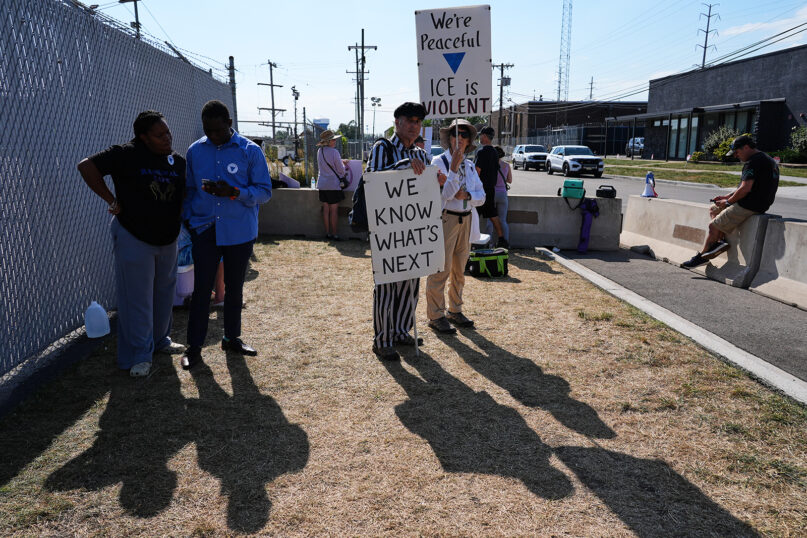
Protesters hold signs outside a U.S. Immigration and Customs Enforcement processing facility in the Chicago suburb of Broadview, Ill., Oct. 6, 2025. (AP Photo/Nam Y. Huh)
Underneath the video, which ends with protesters — not people detained in an immigration enforcement raid — sitting with their hands bound, DHS responded with another post: a link to sign up to join ICE.
The Rev. Quincy Worthington, another Presbyterian minister in the northern Chicago suburbs who has participated in the Broadview protests, called the DHS videos “horribly misguided.”
“It’s an affront to the gospel, plain and simple,” Worthington said.
Worthington said he, too, has endured pepper bullets and tear gas while protesting at the facility. What he has seen there has left him spiritually concerned, and he said he has spent much of the past few weeks immersed in the works of Dietrich Bonhoeffer, a Lutheran pastor who famously opposed Nazis in Germany and was ultimately put to death for his role in an attempted assassination of Adolf Hitler.
Worthington said that at the protests, he tends to spend his time in the crowd offering care to fellow participants. Sometimes that care is physical, such as helping people wash tear gas from their eyes. Other times he offers spiritual care, such as when a woman at the protest suddenly embraced him before bursting into tears.
“She was just so relieved that a member of the clergy was there because it showed her that God hadn’t abandoned them,” Worthington said. “If just my presence can be the presence of Christ to someone, who am I to say no to that?”
